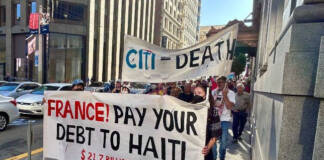by Wanda Sabir
Vote! Vote! Vote! Even if the system is rigged, participate. We vote because to not do so is to dishonor our ancestors. To not do so is to abrogate your rights as a citizen. Everyone cannot participate – 2 million Black men and boys and woman and girls on slave plantations – behind enemy walls, in minimum and maximum custody, cannot participate. We participate for them too. We serve on juries too, because to do so is to unmask an intentionally blind system of injustice.
Maafa 2014
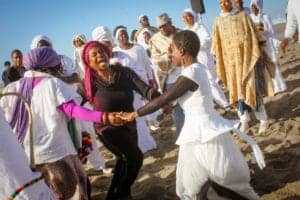
The waves were as tall as mountains or perhaps redwood trees –their gigantic footprints in the sand left many pilgrims flat on their backs wet from head to toe. In 19 years, I’d never seen waves as tall as those that Sunday morning. Many thanks to all who came and made the commemoration a huge success. It was great to have co-founder, Minister Donald Paul Miller, back in the circle. Robert Henry Johnson’s presence also made the morning special, especially when he took a grieving mother’s hand and ran with her around the circle. Big thanks to Zochi too, whose movement meditation practice “mu-i” was such a gift. He teaches “mu-i” at Lake Merritt on Mondays, Wednesdays and Fridays, 8-9:30, at 12th and Lake Merritt Boulevard.
Spirits were certainly rising up. Africans are under attack from police violence to genetically manufactured contagions – Ebola taking off where HIV-AIDS left off. We need fortification against what Dr. Welsing calls White Supremacist Racial Dominance (WSRD). It is a state of emergency for Black people – Dr. Cress Welsing called for revolutionary Black sex to create warriors for the battle. The call went out 23 years ago and not many heard, so it was reiterated recently at the National Conference on African/Black Psychology at Florida A&M University in Tallahassee.
The National Conference on African/Black Psychology at Florida A&M University
I just got back from the National Black Psychology Conference Oct. 24-25. This year FAMU honored Dr. Frances Cress Welsing’s pioneering work on the disease of white supremacy. In the five years FAMU has honored scholars on their contributions to African/Black scholarship, Dr. Cress Welsing is the first woman so named. Known for her collection of essays and lectures, “The Isis Papers: The Keys to the Colors,” it was so wonderful listening to clinicians, students and colleagues present profound readings of Dr. Cress Welsing’s work and its impact on their scholarship, whether that was the dynamic work of Dr. Monifa Seawell, forensic psychiatrist at Georgia Regional Hospital and assistant professor of psychiatry at Morehouse School of Medicine; Arthur Whaley, Ph.D., professor and chair of psychology, Texas Southern University; or Maruetta Williams, Ph.D., and her team’s work in Atlanta at A Healing Paradigm Wellness Center.
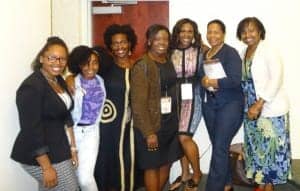
Dr. Williams, doctoral candidate Terrance Jordan and Dr. Idetayo Ojelade, Ph.D., psychologist and clinical director at A Healing Paradigm Wellness Center, presented a well-choreographed “Closer Look at African-Centered Approaches for Assessing Trauma.” All Black people whose ancestors faced the European slave trade have systemic violence connected to this history.
Dr. Seawell’s “Hip-Hopganda: How Hip Hop Serves as Propaganda to Pacify Black Resistance to the Mass Incarceration of Black Men” adeptly outlined how through skillful manipulation, the public castration of the Black male reputation made the incarceration of 2 million Black men – a population size of several countries – somehow justified. It engaged the youthful audience in a provocative conversation afterward. Although she prefaced her talk with “some hip hop music,” she did not promote such mores. What we hear on commercial media does promote Black extermination.
The Healing Paradigm Wellness Center team out of Atlanta looked at the misdiagnosis of Black people in the dominant psychological protocol or models, which ignore “trauma,” a historic and current phenomena in Black lives. The three clinicians asked the audience to define traumatic harm and then through composite case studies showed how ignoring the prevailing symptomatic behavior leads to overmedication and mistreatment of Black people, especially sexually abused Black boys and Black men.
In an interactive workshop, the audience, arranged in groups, then read three composite histories and were asked to identify the illness(es) and propose treatment. Many times within the prescription, groups looked at African-centered healing, some obvious yet powerful “tender loving care” in cases of extreme loss – children of parents.
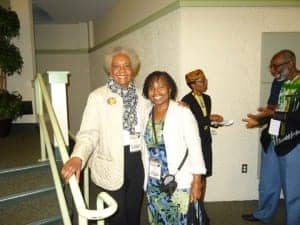
Dr. Lennell Dade, Ph.D., in her “The Destruction of Sanctuary and the Color Confrontation Theory,” looked at the target of churches as a place of intimate Black violation. She looked at the 16th Avenue Church bombing 51 years ago in Birmingham, Alabama, as a case in point. The point is the legal sanction of Black violation. To attack a church, with children as the target, is evil, and its sanction legally, given the slow move of the judicial system, supports the permeation of the white supremacist virus (racism) within American society.
Dr. Marimba Ani and DJ Jordan’s “Economic and Afrikan Mental Health: Some Imperatives of Dr. Cress Welsing’s Analysis” was another high point of the first afternoon – yes, the entire weekend was a high point I plan to float the rest of my life. All of the presenters’ work just further proved that the scholarship is certainly present to remedy the ills of Black consciousness if applied adequately, beginning with self.
The question of Black mental health was revisited over and over again, from retired FAMU faculty member Dr. Kobi Kambon’s stellar introduction to Dr. Frances Cress Welsing’s scholarship, this first section moderated by Dr. Kevin Mwata Washington of Howard University, to Awo Ron “Facundo” Harris’ look at indigenous “African Spirituality as the Missing Tool to Address Personal and Societal Dysfunction.” What is a healthy Black mind and how is this achieved in a society where Black life is constantly under attack? was a question interrogated again and again. Dr. Cress Welsing, queen warrior, psychiatrist, author and scholar, commented periodically between presentations and, each afternoon, formally reflected on the day. Visit www.famu.edu/psychology.
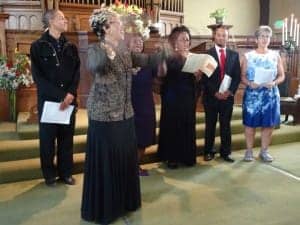
Day one she spoke on the importance of Black self-love – as she had us hug ourselves. The next day she concluded her comments with her “A Liberating Black People’s Prayer,” published in the 2004 re-publication of the 1991 classic, “The Isis Papers,” distributed by Afrikan World Books.
Howard Thurman Award to Jacqueline Hairston
At the 19th Annual Convocation Howard Thurman Award ceremony Sunday, Oct. 19, honoring Jacqueline Hairston on the 70th anniversary of his multiracial Church for the Fellowship of All Peoples, I bought a few books, one the autobiography of Dr. Thurman. In it, I learned that his hometown is Daytona Beach, Florida, which I was going to be traveling to that week. I had to stop by and make my “ashays.” I also stopped at his neighbor’s shrine, Dr. Mary McCleod Bethune at Bethune-Cookman University. I was traveling north from Orlando, my destination Florida A&M University in Tallahassee for the African/Black Psychology Conference honoring the work of Dr. Frances Cress Welsing.
‘Maroon Consciousness’ reading list
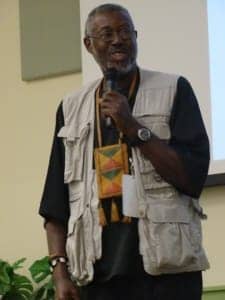
The Maafa San Francisco Bay Area organization ‘Maroon Consciousness’ reading list for 2014-2015 includes: “Obi: Seminole Maroon Freedom Fighter” by Martha R. Bireda, Ph.D.; “Sugaree Rising” by J. Douglass Allen-Taylor; “From the Bottom of the Heap: The Autobiography of Black Panther Robert Hillary King” (2012) by Robert H. King; “Sugar of the Crop: My Journey to Find the Children of Slaves” by Sana Butler (2009); “An Unlikely Warrior: Herman Ferguson” by Iyaluua Ferguson with Herman Ferguson (June 2011); “Maroon The Implacable: the Collected Writings of Russell Maroon Shoatz,” edited by Fred Ho and Quincy Saul with forward by Chuck D (2013); “The Isis Papers: The Keys to the Colors” by Dr. Frances Cress Welsing (1991, 2004); “Yurugu: An African-centered Critique of European Cultural Thought and Behavior” by Marimba Ani, Ph.D. (1994); “Under the Color of Law” by A. Dwight Pettit, J.D. (2011, 2013); “Philosophy and Opinions of Marcus Garvey (1923, 1925),” edited by Amy Jacques Garvey with an introduction by Robert A. Hill (1992); “Marcus Garvey and the Vision for Africa,” edited and with introduction and commentaries by John Henrik Clarke with the assistance of Amy Jacques Garvey (1974, 2011); “Marcus Garvey: Message to the People, The Course of African Philosophy,” edited by Tony Martin (1986); and “Garvey and Garveyism” by Amy Jacques Garvey with John Henrik Clarke (1915-1998) and Julius Garvey, M.D. (Black Classics Press 2014).
If you have books to recommend, send your titles and critique to maafasfbayarea.com@gmail.com. Look at http://maafsafbayarea.com for directions to the interactive “Maroon Consciousness” book discussions. We are starting the conversation with “The Isis Papers: The Keys to the Colors” by Dr. Cress Wesling.
On the fly
The Festival of the Bones, Saturday, Nov. 8, 6:30-8:30 p.m., Oakland Center for Spiritual Living, 5000 Clarewood Drive in Oakland; Oaktown Jazz Workshop 20th Anniversary Benefit concert at Yoshi’s in Oakland, Monday, Nov. 10, 8 p.m., $20 at the door; Muisi-kongo Malonga’s “Kimpa Vita!” at CounterPulse’s Performing Diaspora 2014, Nov. 7-16, Friday-Saturday at 8 p.m. and Sunday at 7 p.m. Kheven Lee LeGrone’s “The Morrie Movement: The Influence of ‘Wee Pals’ Cartoonist Morrie Turner” is up at the African American Center of the San Francisco Main Library, 100 Larkin St., Third Floor, Nov. 8, 2014, to Jan. 29, 2015. The exhibit opening and panel discussion is Nov. 16 from 1-3 p.m. in the Koret Auditorium.
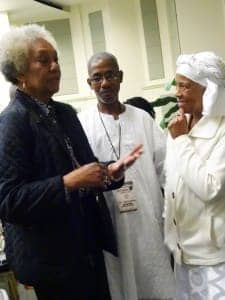
39th Annual American Indian Film Festival is Nov. 1-9 at the AMC Metreon, 135 Fourth St., in San Francisco, with its American Indian Motion Pictures Awards Show Nov. 9 at the Palace of Fine Arts, 3301 Lyon St. in San Francisco, http://aifisf.com/2014-american-indian-film-festival/. This month there are several plays to recommend, not because I have reviewed them yet, because I have not, but because the topic or presentation is thought provoking: The San Francisco African American Shakespeare’s production of “The Tempest” runs Saturdays at 8 p.m. and Sundays at 3 p.m. through Nov. 9, http://www.african-americanshakes.org/. For an interview with the director and cast member plus AA Shakes about this 20th anniversary season, visit http://www.blogtalkradio.com/wandas-picks/2014/09/26/wandas-picks-radio-show-dia-de-los- muertos.
UNIVERSES’ “Party People” at Berkeley Rep through Nov. 16, berkeleyrep.org; L. Peter Callender as President Mugabe in “Breakfast with . . .” at the Aurora Theatre in Berkeley Nov. 7-Dec. 7; Michael Gene Sullivan’s play “Recipe” is up through Nov. 23 at the Berkeley City Club, 2315 Durant Ave., Berkeley, Thursday, Friday and Saturday at 8 p.m. and Sunday at 5 p.m. – with post-show talk-back Nov. 9. Call 510-558-1381 or visit centralworks.org; Naomi Wallace’s “And I and Silence” runs Oct. 29-Nov. 23 at The Magic Theatre, http://magictheatre.org/.
Closing of The 15th annual Day of the Dead exhibition, “Visions at Twilight: Día de los Muertos 2014,” at Somarts Cultural Center through Nov. 8, http://www.somarts.org/. “Think on These Things: Destiny Muhammad’s Birthday Concert” is 6-8 p.m. Sunday, Nov. 14, at the Malonga Casquelourd Center for the Arts, 1428 Alice St. in Oakland, www.harpistfromthehood.com. Attitudinal Healing Center’s 25 Years of Loving Our Community Gala Awards is Nov. 15, 6-10 p.m., at Scott’s Seafood Pavilion, 2 Broadway, Oakland, with Special Super Hero Awards to Belva Davis, Paul Cobb, Dr. Tom Pinkson and Steve A. Jones.
‘Traveling While Black,’ a review
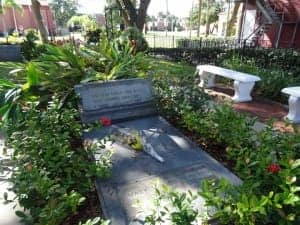
“Traveling While Black” is epic. It is a story that has audiences laughing while at the same time catching their breath as Edris Cooper-Anifowoshe takes us with her into situations only a well-written narrative can then retrieve us from unscathed.
The journey is fraught with peril. And for those who thought only Black men had it rough, Cooper-Anifowoshe quickly erases that illusion as she transports us from a Muni bus ride in San Francisco to a slave ship off the coast of West Africa without a blink of an eye. Seamless transport – the shocks keep us comfortable, so comfortable we don’t miss or feel the millions lost on the journey with us as “TWB” takes us through the massacre of the Indigenous populations here to the separation of Black people abroad, via countries of origin. All of a sudden TWB with an American passport removes the racial stigma and one is just an “American” traveling.
Cooper-Anifowoshe uses her experiences as a child growing up in Tennessee and Arkansas with a nuclear physicist dad, who liked to get in the car with his children and take them on road trips, to share her early experiences TWB in America. Those who know the playwright’s trajectory know this is the condensed version of the story – she leaves out a lot, but what we see is her navigation of a racially articulated paradigm that keeps beeping when she gets too close to a border or treaty or international agreement. This border or margin is also complicated by gender and national origin.
Using a color-coordinated fleet – a boat, an airplane and a suitcase – Cooper-Anifowoshe sails from Spain to Morocco then takes a plane to Nigeria, then to Abidjan, where finally she’s home. The story of her welcome there is one all people of the Diaspora need to feel.
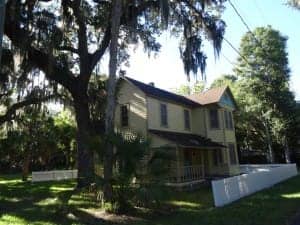
All along the journey we hear Cooper-Anifowoshe’s mother and father. In fact, “TWB” shows that one cannot leave oneself behind when one changes landscape; however, it is good to check the baggage or lock it away before one boards the plane. “TWB” shows how having the right attitude and being able to think quickly on one’s feet can save a person’s life as TWB is not for the faint of heart.
No, it takes a lot of heart to TWB, especially when traveling with ignorant companions – white Americans with the wrong attitude. She saves her companion’s life more than once and then decides it isn’t worth the risk, so she “veils up” and leaves him in a pool of blood.
Anifowoshe-Cooper talks about a cultural orientation that has white American students from Iowa University thinking it strange that there are no white people (or few) in Africa, nor do they find it easy to adjust to the fact that Black people are in charge.
She realizes her white traveling companions are a risk, yet as their teacher she cannot leave them at the airport (smile). The multiple narratives are funny as the actress parades through many masks, one a sister-friend who doesn’t greet fake camaraderie well when the white Americans (those same students) want to be friends in Africa, when in Iowa they could barely speak to her.
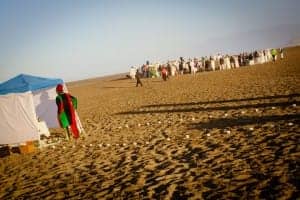
TWB shifts for Cooper-Anifowoshe when, with dual citizenship, once she marries a Yoruba man, she can choose to show her green African passport or blue American passport. Cooper-Anifowoshe speaks about how sad she and her newly minted African American students felt when they saw how disrespectfully people they’d come to respect and love were treated by American immigration. The newlywed had to leave her husband behind.
After the show, a friend of mine tells me the story of her husband, who was caught in Egypt when the Americans were held by Iran and the airports were shutting down. Marty held up his blue passport, and he was able to board one of the last planes leaving North Africa.
With Cooper-Anfowoshe, we visit former Southern plantations, slave ships, the Shrine in Lagos while Fela lay ill behind the curtain, sacred places along the Oshun river. We run for our lives with Edris as boys chase her and others in Spain with ill intent, bricks sailing by her head. We get pulled over in a SF Mime Troupe truck by Southern cops who take the driver and passengers in for questioning after finding contraband in the vehicle – Black and white people.
It is a wonderful jaunt. Cooper-Anifowoshe, wearing an earring with the outline of Africa jauntily swinging from one ear, talks plenty smack during the never a dull moment sojourn at home and abroad. “TWB” is lively, the pacing is up tempo, the text sharp and witty – it is as if we dropped by the playwright’s house for the evening following a time away to catch up on the news.
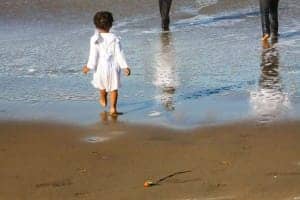
Considering this is a long overdue visit – the hundreds of years between conversations, time travel and continent hopping – Cooper-Anifowoshe ends where she started: San Francisco on the 14 bus. Standing on the crowded bus, the lights fade.
I believe the 14 bus has one of the longest routes in San Francisco; at least it goes through more neighborhoods with a changing demographic than any other. I saw a film about this at the Mill Valley or San Francisco International Film Festival many years ago – Rhodessa Jones, founder of the Medea Project, is in it. The bus goes through Noe Valley, her neighborhood.
For information about Brava, visit www.brava.org.
Recent articles about TWB:http://www.nytimes.com/2014/01/05/travel/traveling-while-black.html?_r=0, http://www.huffingtonpost.com/oneika-raymond/musings-on-traveling-while-black_b_4552607.html and http://www.essence.com/2013/01/07/real-talk-tales-traveling-while-black/.
Funny, none of these stories are from a Black American male perspective.
Appreciative Inquiry on Diaspora Citizenship Launch (Nov. 2014-June 2015)
I have gotten many letters from incarcerated men about the query, so I am going to list the questions here so anyone can respond and send in the answers to the questions. An Appreciative Inquiry (different from Critical Inquiry) for those unfamiliar with the term is an assessment tool used in organizations to figure out what the individuals bring to the institutions. It focuses on what’s working well, rather than on deficits or what is not. In the organizational context, it recognizes people as key value factors in maximizing profit and institutional growth. So, investing in the people makes good economic sense.
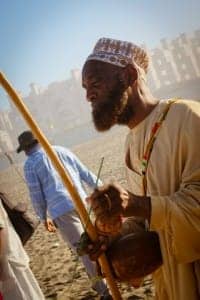
Those invited to participate are Black people who have lived outside continental Africa (Pan African Diaspora) is 300-600 years. We are speaking ancestral lineage now, of course. The goal of the conversation is to generate stories we can share to cross landscapes to redevelop a shared African peoplehood cosmology.
My hypothesis is that Diaspora Africans are more closely connected than they know and that this global conversation can be a way to assist one another in establishing long overdue civil rights where we are. Secondly, as immigrants, though the majority unwillingly, we have a right to return to continental Africa – as Diaspora citizens. UNIA President General Senghor Jawara Baye said there are certain rights as expatriates we can exercise as Diaspora citizens.
In each question, please tell us a least one story (you can tell as many as you like).
- What does the term Diaspora mean to you? How would you define citizenship? Now put the terms together. What do you come up with?
- What strengths do you draw from this multiplicity of consciousness?
- Where are you a citizen? (This can be a multiple location terrain). What rights do you exercise where you are a citizen?
- You have identified as a Diaspora citizen; think of a few stories you can share that speak to the power you wield as such a person, even if, up to this moment, you never really considered the term before.
- Where do you belong? Describe the place that contains or holds your brilliant legacy and history. If such a place doesn’t exist, imagine it for us. Now where will you build it?
- Who are your people? Do they claim you as well? Tell a few stories about such community. Did you choose it or were you born into it?
- How does membership in the Diaspora community and its legacy shape your thinking?
- Marcus Garvey, Pan African visionary leader of the Universal Negro Improvement Association-African Communities League, said, “Up, you mighty race! You can accomplish what you will!” He also said, “One God, One Aim, One Destiny.”
Question: How do you see either of these sayings reflected in your moral code? Tell us a story of a recent action that speaks to the actualization of this idea?
- What strengths do you draw from this multiplicity of consciousness?
- What do you want to see for your people in the Diaspora? Be concrete and definitive.
- What are first steps towards this actualization?
- What would you like to see as an outcome for this query? Put the outcome on a timeline. What would need to be in place to make it happen? What can you offer to make this a reality?
- If you could travel anywhere on the planet tomorrow, where in the Diaspora would you like to go? Who would you like to meet?
- What question(s) would you like to add?
Please also include a brief note giving me permission to use your words in my research on Diaspora Citizenship. You will still possess the intellectual rights to your work. Send to P.O. Box 30756, Oakland, CA 94604 or email to diasporacitizenship@gmail.com.
Bay View Arts Editor Wanda Sabir can be reached at wanda@wandaspicks.com. Visit her website at www.wandaspicks.com throughout the month for updates to Wanda’s Picks, her blog, photos and Wanda’s Picks Radio. Her shows are streamed live Wednesdays at 7 a.m. and Fridays at 8 a.m., can be heard by phone at 347-237-4610 and are archived at http://www.blogtalkradio.com/wandas-picks.





